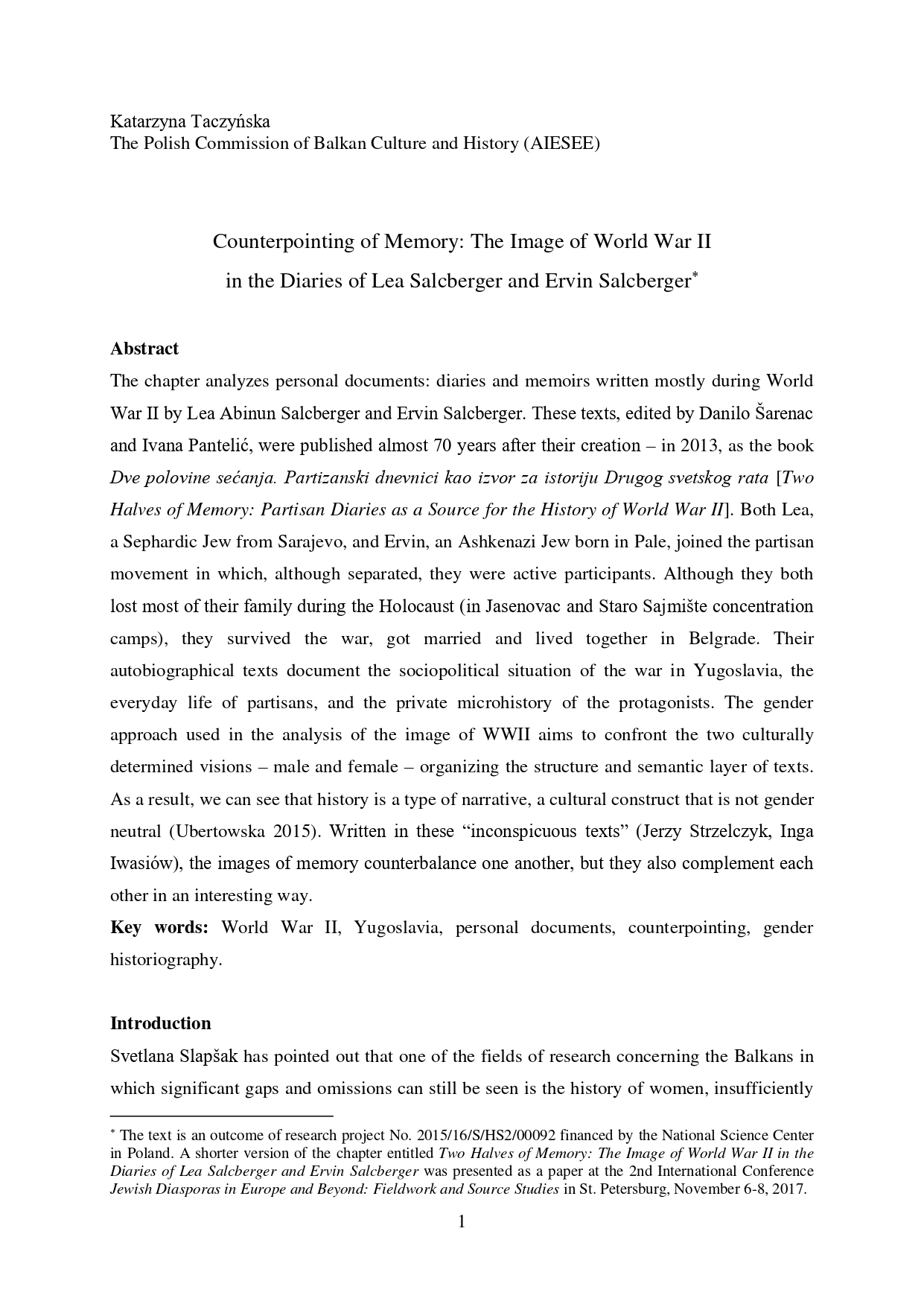Приказ основних података о документу
Counterpointing of memory: the image of World War II in the diaries of Lea Salcberger and Ervin Salcberger
Kontrapunkty pamięci: obraz drugiej wojny światowej w dziennikach Lei Salcberger i Ervina Salcbergera
| dc.creator | Taczyńska, Katarzyna | |
| dc.date.accessioned | 2024-02-16T13:04:20Z | |
| dc.date.available | 2024-02-16T13:04:20Z | |
| dc.date.issued | 2020 | |
| dc.identifier.uri | https://www.jevrejskadigitalnabiblioteka.rs/handle/123456789/2671 | |
| dc.description.abstract | The chapter analyzes personal documents: diaries and memoirs written mostly during World War II by Lea Abinun Salcberger and Ervin Salcberger. These texts, edited by Danilo Šarenac and Ivana Pantelić, were published almost 70 years after their creation - in 2013, as the book " Two Halves of Memory: Partisan Diaries as a Source for the History of World War II”. Both Lea, a Sephardic Jew from Sarajevo, and Ervin, an Ashkenazi Jew born in Pale, joined the partisan movement in which, although separated, they were active participants. Although they both lost most of their family during the Holocaust (in Jasenovac and Staro Sajmište concentration camps), they survived the war, got married and lived together in Belgrade. Their autobiographical texts document the sociopolitical situation of the war in Yugoslavia, the everyday life of partisans, and the private microhistory of the protagonists. The gender approach used in the analysis of the image of WWII aims to confront the two culturally determined visions - male and female - organizing the structure and semantic layer of texts. As a result, we can see that history is a type of narrative, a cultural construct that is not gender-neutral (Ubertowska 2015). Written in these “inconspicuous texts” (Jerzy Strzelczyk, Inga Iwasiów), the images of memory counterbalance one another, but they also interestingly complement each other. | sr |
| dc.description.abstract | W niniejszym rozdziale analizuję powstałe głównie w czasie drugiej wojny światowej dokumenty osobiste: dzienniki i wspomnienia autorstwa Lei Abinun Salcberger i Ervina Salcbergera. Teksty te w opracowaniu Danilo Šarenaca i Ivany Pantelić zostały opublikowane prawie 70 lat po powstaniu, w 2013 r. w książce Dve polovine sećanja. Partizanski dnevnici kao izvor za istoriju Drugog svetskog rata. Lea, pochodząca z Sarajewa Sefardyjka, i Ervin, urodzony w Pale Żyd aszkenazyjski, byli uczestnikami ruchu partyzanckiego, w którym, choć rozdzieleni, aktywnie działali. Choć oboje stracili większość rodziny w czasie Holokaustu (obóz Jasenovac i Staro Sajmište), oni sami wojnę przeżyli, pobrali się i żyli razem w Belgradzie. Ich autobiograficzne teksty dokumentują zarówno społeczno-polityczną sytuację wojny w Jugosławii, codzienne życie partyzantów, jak i prywatną mikrohistorię swoich bohaterów. Wykorzystywane w analizie obrazu drugiej wojny światowej podejście genderowe ma na celu konfrontację dwóch zdeterminowanych kulturowo wizji – męskiej i żeńskiej, organizujących strukturę oraz warstwę semantyczną tekstów. W rezultacie widzimy, że historia to przede wszystkim narracja, kulturowy konstrukt, który nie jest neutralny genderowo (Ubertowska 2015). Zapisane w tych „tekstach niepozornych” (Jerzy Strzelczyk, Inga Iwasiów) obrazy pamięci stanowią dla siebie przeciwwagę, ale również w ciekawy sposób dopełniają się. | sr |
| dc.description.abstract | U poglavlju se analiziraju lični dokumenti: dnevnici i memoari koje su uglavnom pisali Lea Abinun Salcberger i Ervin Salcberger tokom Drugog svetskog rata. Ovi tekstovi, koje su uredili Danilo Šarenac i Ivana Pantelić, objavljeni su skoro 70 godina od nastanka - 2013. godine, kao knjiga „Dve polovine sećanja. Partizanski dnevnici kao izvor za istoriju Drugog svetskog rata. I Lea, sefardska Jevrejka iz Sarajeva, i Ervin, Jevrejin Aškenazi rođen na Palama, stupili su u partizanski pokret u kome su, iako razdvojeni, bili aktivni učesnici. Iako su oboje izgubili većinu porodice tokom Holokausta (u logorima Jasenovac i Staro Sajmište), preživeli su rat, venčali se i zajedno živeli u Beogradu. Njihovi autobiografski tekstovi dokumentuju društveno-političku situaciju rata u Jugoslaviji, svakodnevicu partizana i privatnu mikroistoriju protagonista. Rodni pristup koji se koristi u analizi slike Drugog svetskog rata ima za cilj da suprotstavi dve kulturološki određene vizije - mušku i žensku - organizujući strukturu i semantički sloj teksta. Kao rezultat toga, možemo videti da je istorija tip narativa, kulturni konstrukt koji nije rodno neutralan (Ubertowska 2015). Napisane u ovim „neupadljivim tekstovima“ (Jerzi Strzelczik, Inga Ivasiov), slike sećanja su jedna drugoj protivteža, ali se i zanimljivo dopunjuju. | sr |
| dc.language.iso | en | sr |
| dc.publisher | [S. l.] : Südosteuropa | sr |
| dc.rights | openAccess | sr |
| dc.rights.uri | https://creativecommons.org/licenses/by/4.0/ | |
| dc.source | The Balkan Jews and the Minority Issue in South-Eastern Europe | sr |
| dc.subject | Drugi svetski rat | sr |
| dc.subject | Holokaust - Jugoslavija | sr |
| dc.subject | lična dokumenta | sr |
| dc.subject | kontrapunkt | sr |
| dc.subject | rodna istoriografija | sr |
| dc.subject | World War II | sr |
| dc.subject | Holocaust - Yugoslavia | sr |
| dc.subject | personal documents | sr |
| dc.subject | counterpointing | sr |
| dc.subject | gender historiography | sr |
| dc.title | Counterpointing of memory: the image of World War II in the diaries of Lea Salcberger and Ervin Salcberger | sr |
| dc.title | Kontrapunkty pamięci: obraz drugiej wojny światowej w dziennikach Lei Salcberger i Ervina Salcbergera | sr |
| dc.title | Kontrapunkt sećanja: Slika Drugog svetskog rata u dnevnicima Lee Salcberger i Ervina Salcbergera | sr |
| dc.type | bookPart | sr |
| dc.rights.license | BY | sr |
| dc.identifier.fulltext | http://jevrejskadigitalnabiblioteka.rs/bitstream/id/8543/CounterpointingOfMemoryOCR.pdf | |
| dc.type.version | publishedVersion | sr |
| dc.citation.spage | 1 | |
| dc.citation.epage | 16 | |
| dc.description.other | The text is an outcome of research project No. 2015/16/S/HS2/00092 financed by the National Science Center in Poland. A shorter version of the chapter entitled "Two Halves of Memory: The Image of World War II in the Diaries of Lea Salcberger and Ervin Salcberger" was presented as a paper at the 2nd International Conference "Jewish Diasporas in Europe and Beyond: Fieldwork and Source Studies in St. Petersburg", November 6-8, 2017. | sr |
| dc.identifier.rcub | https://hdl.handle.net/21.15107/rcub_jdb_2671 |

